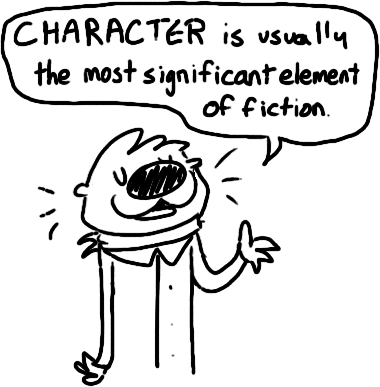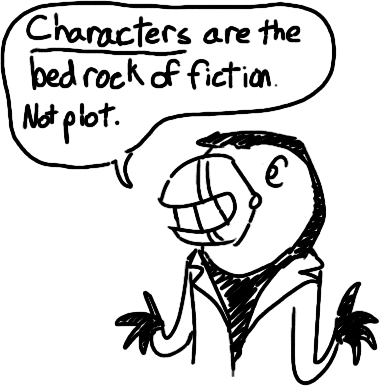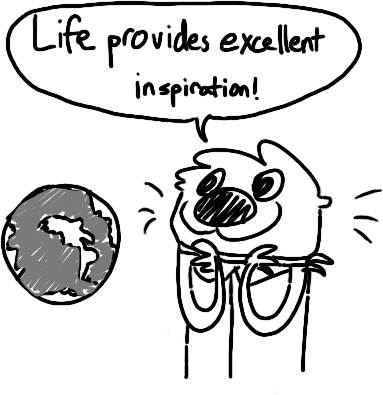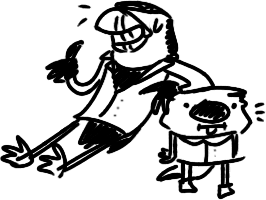dadevvtsvre
Sponsor


- Section 1: What Makes A Character?
- Section 2: Flesh and Guts - Developing Your Characters
- Section 3: The Brave and the Bold - Creating Your Hero
- Section 4: Building Memorable Bad Guys - A Guide to Villains
- Section 5: Sidekicks, Love Interests, Minor Characters, etc.

I’m not a pro writer or anything, but I’ve been studying and writing fiction for a couple of years. I’ve taken several classes on writing, have read more books than I can count, and have been seriously learning how to write for a long time. I’m working on writing a novel at the moment, and even though progress is slow, I’ve taken a lot of time to really learn fiction, from the inside-out.
Characters are a fascinating subject to me. They’ve been my favourite part about creating fiction for as long as I can remember. Although this workshop is written from a novel-based stance, the information in here can be applied to virtually any kind of fiction – be it video games, movies, short stories, comics, etc.
Most characters in video games are very two-dimensional, and rarely are they developed except in RPGs. Even in many RPGs, characterization is shunned, emphasizing graphics, gameplay and music. This is fine – after all, we make games for playing, not for reading. However, if you plan on creating a very plot- and character-heavy RPG, then there could be some good information in this workshop for you.
I’ve compiled information and advice for a variety of sources, including authors, scholars, and screenwriters. Take a look, tell me what you think. Not all of this is actually MY advice; some of it is derived from actual writers and junk.
Cool. Let’s do this.


In novels, fiction has four main components: Plot, Setting, Theme, and Character (five components, if you want to be a weirdo and count Style.) They’re pretty self-explanatory, and you might remember them from high school English class. Plot, or narrative, is the sequence of events that occurs in your story; in other words, what happens. Setting is when and where your story takes place. Theme can be described as the “ultimate truth” contained in your story, which some simplify as a moral. And character, quite simply, are the people that inhabit your story and experience the plot.
It’s important to remember that different works of fiction will emphasize different elements. J. R. R. Tolkien’s The Lord of the Rings trilogy and China Miéville’s Bas-Lag novels are two examples of books that place notable emphasis on their rich and expansive settings. Aesop’s Fables and many stories in the Bible are well-known examples of stories that emphasize theme above all else.
However, in most novels, character is usually the most significant element of fiction. This comes as a surprise for some, who consider plot to be the most crucial, so it’s important to understand why.
When you think of memorable works of fiction, what stands out the most? Characters such as Harry Potter, Scarlett O’Hara, Dracula, Tom Sawyer, Elizabeth Bennet, Holden Caulfield and Sherlock Holmes are known around the world, and their legacies have endured for decades. Less often can people recall their plots.
Characters are the bedrock of fiction. Heroes and villains are far more memorable than plot, setting and theme any day of the week. As a result, the writer’s greatest challenge is character development.
Good fiction can have any subject, as long as that subject is about PEOPLE. When we are immersed in the lives of characters, and want to learn more, the writer has succeeded.

- Characters are “larger than life” and may live outside social norms and conformity in some way.
- They evoke reactions in others, often creating sympathy (or better yet, empathy.)
- Characters have one particular dimension of their personality that is strong – so much so that it may make them single-minded and self-absorbed – yet they typically attract and inspire others.
- They may have a passion and depth of feeling that they “wear on the outside.”
- Overall, they tend to be unapologetically and unself-consciously themselves (this trait is less important in characters who lack identity, for obvious reasons.)
Most novice writers (myself included) often neglect characterization, instead focusing on the much easier component of fiction – plot. However, when writers forget that characters make for more interesting stories than plot, the result is a sloppy cast of boring, stiff, all-too-fictional people. Novices often forget that writing a story about war is never as good as writing a story about men AT war. The first thing to realize when choosing a subject for fiction is that you must write about people.
The most engaging characters in fiction are the ones who exist in our minds so vividly that we almost believe they’re real people. Bad characters are those that exist in our minds solely as works of fiction, who are forgettable and never leap off the pages. Good characters are those that seem so real, we treat them as long-lost friends or enemies.
Giving characters names and dialogue does not make them real. It takes a lot to build a memorable character, involving a process in which we learn who our characters are, and what they’re made of. I am of the belief that an author shouldn’t start writing about a character until they know them so well, they treat them as a real person. When you can sit down, have an imaginary interview with a character, and know exactly what they’re going to say, then you can start. When your character is no longer fictional, and is as real to you as your best friend or your worst enemy, then you’re ready to write.











